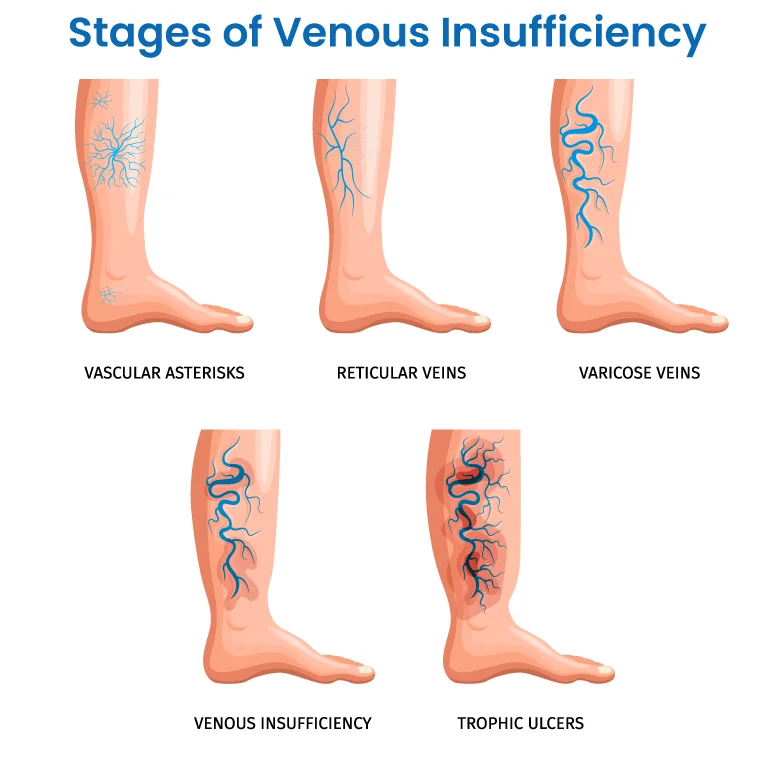Subscribe to get weekly insights
Always stay up to date with our newest articles sent direct to your inbox
Published on 20 Aug, 2025
Updated on 20 Aug, 2025
10 Views
5 min Read

Written by Gungun Bhatia
Reviewed by Munmi Sharma
favorite0Like
favoriteBe the First to Like
Is It Just Leg Swelling—or Something More? Even Donald Trump Was Diagnosed with CVI!
We usually think those long days sitting or standing cause our legs to swell and feel discomfort. But, hey, what if it’s a red flag for something more serious? Chronic Venous Insufficiency (CVI) is a progressive and often overlooked condition that affects millions worldwide, including high-profile individuals. In fact, former U.S. President Donald Trump was recently diagnosed with CVI, bringing much-needed attention to this circulatory disorder.
While Trump’s diagnosis grabbed headlines, millions around the world—especially those over 50—live with CVI without even realising it. Let’s break it down—what it is, how it affects the body, and what you can do to prevent and manage it.
Chronic venous insufficiency is a long-term condition in which the veins in your legs have trouble sending blood back to your heart. It happens when the valves in your veins get weak or damaged, which causes blood to collect in your legs and feet instead of flowing as it should.
In a healthy circulatory system, veins have valves that prevent blood from flowing backwards and keep it moving up to the heart. But with chronic venous insufficiency, these valves don't close. This causes blood to flow backwards, leading to swelling and other chronic venous insufficiency symptoms.
Several factors can contribute to venous insufficiency, including:
CVI is typically classified into six stages based on severity:

Early detection and treatment can halt or slow progression.
Many people initially dismiss symptoms of chronic venous insufficiency as minor inconveniences. However, understanding these early signs is crucial:
If you notice one or more of these chronic venous insufficiency symptoms, consult a healthcare provider for evaluation.
Diagnosing CVI typically involves:
Early diagnosis can prevent the disease from progressing to more severe stages, such as leg ulcers or chronic skin infections.
Chronic venous insufficiency doesn’t just affect your legs. Over time, it can lead to:
Fortunately, venous insufficiency treatment has advanced significantly. Treatment depends on the severity and stage:
A little change in your daily routine can make a significant difference. Follow the tips below to reduce the risk of venous insufficiency in your life:
Therapies are the game-changer for every medical condition. In case of CVI, you can take compression therapy to enhance the blood flow.
If you are experiencing chronic venous insufficiency symptoms, it is always advisable to consult a doctor and start the medications. Here are the importance of medications:
Minimally invasive procedures, also known as minimally invasive surgeries, are procedures that involve smaller incisions and a faster recovery. It is quite different from open surgeries. Here’s the list of MIS that can be used in venous insufficiency treatment:
These treatments are often outpatient procedures with minimal downtime. However, chronic venous insufficiency treatment costs can drain you financially. But that’s where Care Health Insurance steps in.
With Care’s mediclaim policy, you can get coverage for day care procedures, diagnostic tests, and specialist consultations. We at Care help ease the financial burden of managing chronic conditions, like CVI. You can also encounter cashless hospitalisation, no-claim bonuses, and lifelong renewability, ensuring that your vein, health and your wallet stay in good shape.
Lifestyle changes, especially diet, can significantly help manage CVI. A diet for venous insufficiency focuses on:
It is always advisable to avoid processed foods, excessive salt, and saturated fats that contribute to poor circulation.
>> Also Read: Home Remedies for Varicose Veins
While some risk factors (like age or genetics) are unavoidable, you can take preventive steps:
Living with Chronic Venous Insufficiency
With the right approach, people with Chronic Venous Insufficiency can lead active, fulfilling lives. Here’s how:
Remember, early intervention makes a significant difference. Don’t ignore swollen legs—they could be a sign of something your veins are trying to tell you.
Chronic venous insufficiency isn't rare, and it can happen to anyone. Donald Trump’s diagnosis served as a reminder that even high-profile individuals aren’t immune. Prevention is key—especially for those with risk factors. Spotting the symptoms early, understanding what causes it, and making some changes to your life can really improve how you feel.
Don't ignore leg swelling or discomfort. These might be signs that your veins need some care. With the right treatment, you can manage CVI and stay active without pain.
Disclaimer: The above information is for reference purposes only. Kindly consult your general physician for verified medical advice. The health insurance benefits are subject to policy terms and conditions. Refer to your policy documents for more information.
favoriteBe the First to Like
शुगर कंट्रोल कैसे करे? जानें, डायबिटीज में क्या खाना चाहिए Vipul Tiwary in Health & Wellness
Thyroid : मामूली नहीं हैं महिलाओं में थायराइड होना, जानें इसके लक्षण और घरेलू उपचार Vipul Tiwary in Diseases
हाई ब्लड प्रेशर को तुरंत कंट्रोल कैसे करें? देखें इसके उपाय Vipul Tiwary in Diseases
प्लेटलेट्स की कमी के लक्षण, कारण और इलाज क्या है Vipul Tiwary in Diseases
7 Hidden Benefits that Make Cayenne Pepper Worth the Hype Jagriti Chakraborty in Health & Wellness
Septoplasty or Rhinoplasty: Which is the Best Nose Surgery? Sejal Singhania in Diseases
Is Pregnancy After 35 Safe? Facts About Advanced Maternal Age! Sejal Singhania in Health Insurance Articles
This is How Cortisol Symptoms Can Destroy Your Health! Sejal Singhania in Diseases